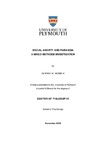Social anxiety and paranoia: A mixed-methods investigation
| dc.contributor.supervisor | Andrade, Jackie | |
| dc.contributor.author | Homer, Sophie Ruth | |
| dc.contributor.other | Faculty of Health | en_US |
| dc.date.accessioned | 2019-08-14T16:31:19Z | |
| dc.date.issued | 2019 | |
| dc.identifier | 10288863 | en_US |
| dc.identifier.uri | http://hdl.handle.net/10026.1/14798 | |
| dc.description.abstract |
Social anxiety is highly prevalent and highly debilitating. It is detrimental to educational and occupational progression as well as quality of life for up to 12% of the population. Current research, treatment, and diagnostic criteria maintain that the cause of anxiety in social situations is self-focused fear, usually of personal inadequacy, but social situations invariably involve both the self and other people. This thesis draws upon the paranoia literature to inform arguments about the role of negative perceptions of others in social anxiety. I propound a novel theoretical model of the core fears underlying social anxiety. I argue that anxiety in social situations can result from fears surrounding the nature and intentions of others as well as self-focused fears. The model yields several testable predictions which were investigated using a mixed-methods approach. I present an in-depth qualitative exploration of perceptions of self and others in eleven socially anxious individuals with varying levels of paranoia. I describe two experimental tests of the causal relationships between negative perceptions of self and others and social anxiety in a total of 229 participants. I also validate three new psychometric measures in a sample of 622, including socially anxious and healthy subsamples. The results of these studies support the main predictions of the theoretical model. Fears surrounding both self and others cause anxiety and social anxiety, and these core fears are strongly correlated with one another. These findings imply that the role of perceptions of others has been underestimated in previous social anxiety research and treatment. Theoretical advancements could improve diagnosis and treatment and generate new research questions. Primarily, further investigation should focus on the causal relationships between these core fears. The new psychometric tools presented here enable measurement of each. They will facilitate research and could also improve formulation and assessment in clinical practice. | en_US |
| dc.language.iso | en | |
| dc.publisher | University of Plymouth | |
| dc.subject | Psychology | en_US |
| dc.subject | Clinical psychology | en_US |
| dc.subject | Applied psychology | en_US |
| dc.subject | Social anxiety | en_US |
| dc.subject | Paranoia | en_US |
| dc.subject | Anxiety | en_US |
| dc.subject.classification | PhD | en_US |
| dc.title | Social anxiety and paranoia: A mixed-methods investigation | en_US |
| dc.type | Thesis | |
| plymouth.version | publishable | en_US |
| dc.identifier.doi | http://dx.doi.org/10.24382/1141 | |
| dc.rights.embargodate | 2020-08-14T16:31:19Z | |
| dc.rights.embargoperiod | 12 months | en_US |
| dc.type.qualification | Doctorate | en_US |
| rioxxterms.version | NA | |
| plymouth.orcid.id | https://orcid.org/0000-0002-1825-5533 | en_US |
Files in this item
This item appears in the following Collection(s)
-
01 Research Theses Main Collection
Research Theses Main


